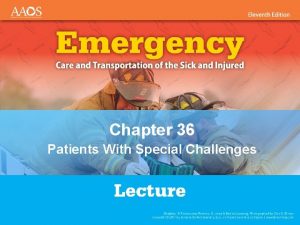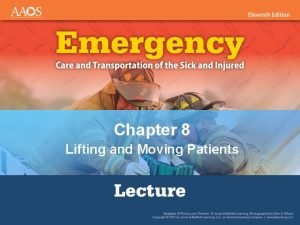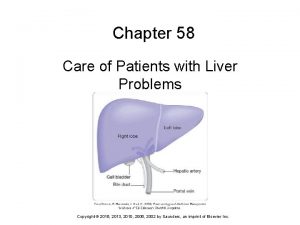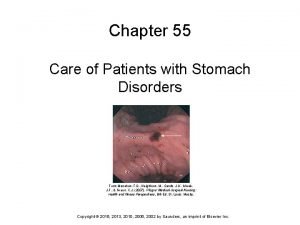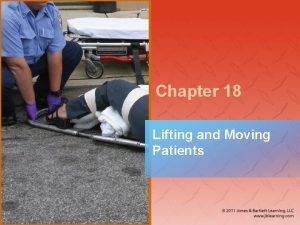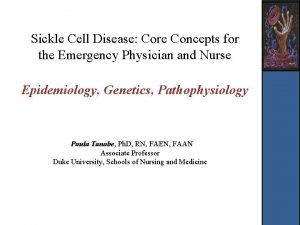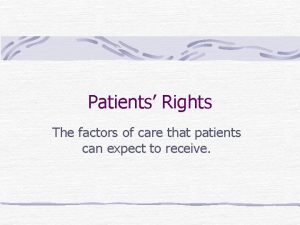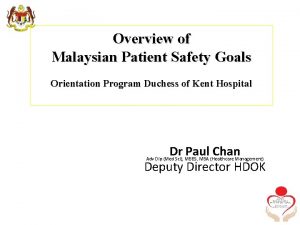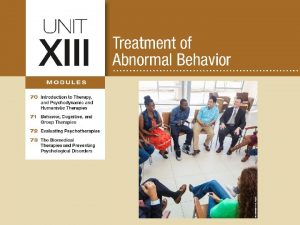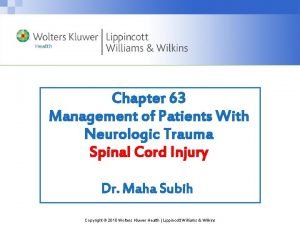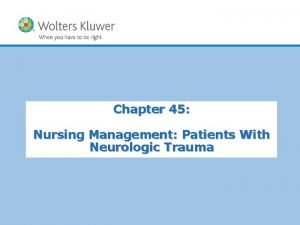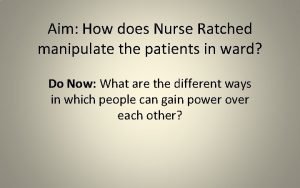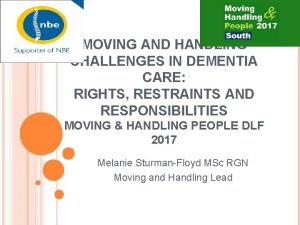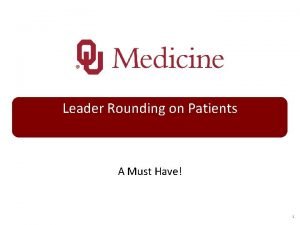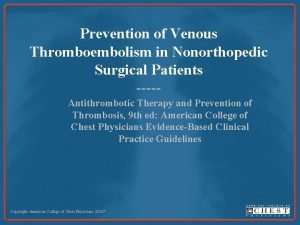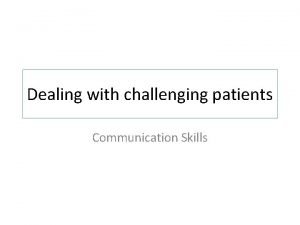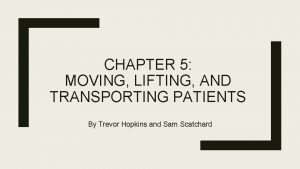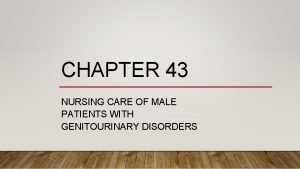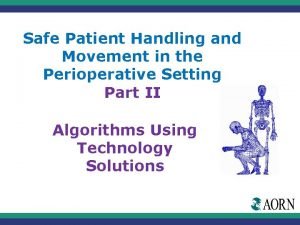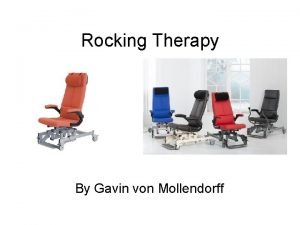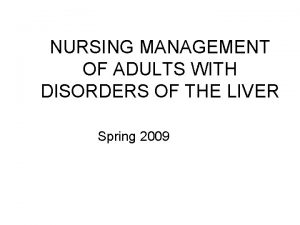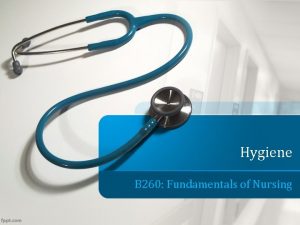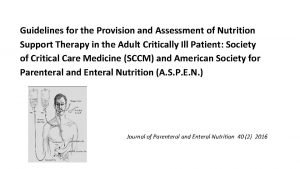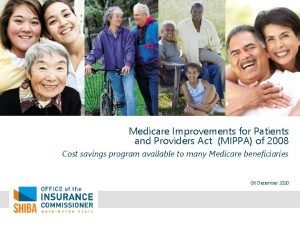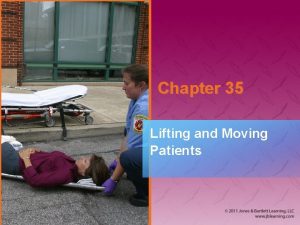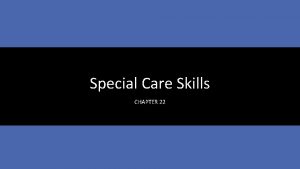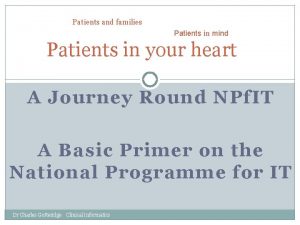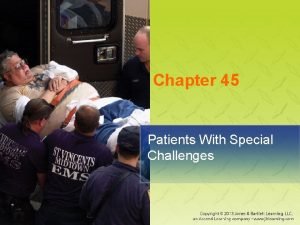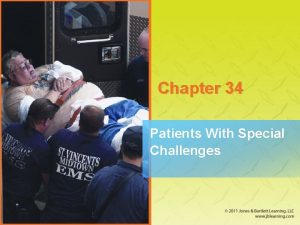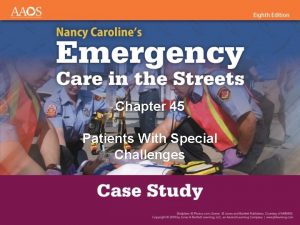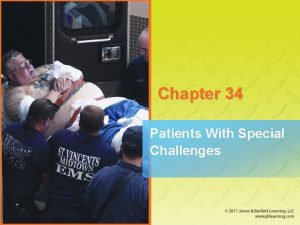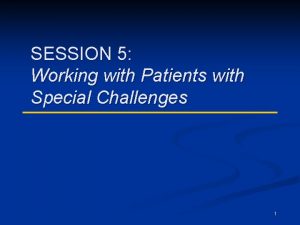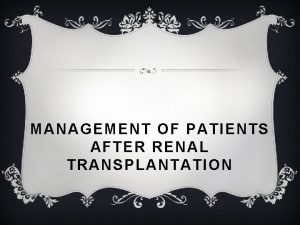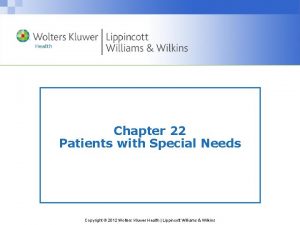Chapter 36 Patients With Special Challenges Introduction Today
























































































- Slides: 88

Chapter 36 Patients With Special Challenges

Introduction • Today more people with chronic diseases live at home. • Some patients depend on mechanical ventilation, intravenous pumps, and other devices. • Do not be distracted by the equipment! • Focus on the patient.

Intellectual Disability (1 of 3) • Developmental disability – Insufficient development of the brain resulting in some level of dysfunction or impairment – Includes intellectual, hearing, or vision impairments • Intellectual disability – Results in the inability to learn and socially adapt at a normal developmental rate

Intellectual Disability (2 of 3) • Slight impairment: – Slow to understand or limited vocabulary – Behave immaturely compared to peers • If severe, may have inability to care for themselves, communicate, understand, or respond

Intellectual Disability (3 of 3) • Rely on patients and family members for information. • Patient may have difficulty adjusting to change or a break in routine. • Patients with intellectual disabilities are susceptible to the same diseases as other patients.

Autism Spectrum Disorder (1 of 2) • Developmental disorder characterized by impairment of social interaction – Severe behavioral problems – Repetitive motor activities – Impairment in verbal and nonverbal skills – May be hyper- or hyposensitive to sensory stimuli

Autism Spectrum Disorder (2 of 2) • Wide spectrum of disability • Patients have difficulty using or understanding nonverbal communication. – Do best with simple, one-step directions • Affects males five times more than females • Rely on parents/caregivers for information

Down Syndrome (1 of 3) • Genetic chromosomal defect during fetal development – Causes mild to severe intellectual impairment • Physical abnormalities: – Round head with flat occiput – Enlarged, protruding tongue – Slanted, wide-set eyes

Down Syndrome (2 of 3) • Increased risk for medical complications – 40% may have heart conditions and hearing and vision problems • Intubation may be difficult due to large tongues and small oral and nasal cavities. – Mask ventilation can be challenging – Jaw-thrust or nasopharyngeal airway may be necessary.

Down Syndrome (3 of 3) • Management of seizures is the same as for any other patent • The atlantoaxial joint is unstable in approximately 15% of patients – Increased risk of complications when they experience trauma

Patient Interaction • It is normal to feel uncomfortable. • Approach in a calm, friendly manner. • Introduce team members. • Explain what you are going to do. • Move slowly but deliberately. • Watch for signs of fear and soothe anxiety. • Establish trust and communication.

Brain Injury • Patients with a prior brain injury may be difficult to treat. • Talk with patient and family. – Establish what is considered normal for the patient. • Explain procedures and reassure patient.

Visual Impairment (1 of 3) • Possible causes • Range in degree of visual impairment – Some patients lose peripheral or central vision – Some can distinguish light from dark or shapes • May be difficult to recognize

Visual Impairment (2 of 3) • Patient interaction – Make yourself known when you enter. – Introduce yourself and your team. – Retrieve any visual aids and give them to your patient. – Patient may feel vulnerable and disoriented. – Describe the situation and surroundings to the patient.

Visual Impairment (3 of 3) • Transport considerations – Take cane or walker, if used. – Make arrangements for care or accompaniment of service animal. – Patients should be gently guided, never pulled or pushed. – Communicate obstacles in advance.

Hearing Impairment • Problems range from slight hearing loss to total deafness. – Many older people have some hearing loss. • Common forms of hearing loss • Clues that a person could be hearing impaired

Communication With Hearing Impaired Patient (1 of 2) • Assist the patient with finding and inserting any hearing aids. • Face the patient while you communicate. • Do not exaggerate your lip movements or look away. • Position yourself approximately 18″ directly in front of the patient.

Communication With Hearing Impaired Patient (2 of 2) • Do not speak louder; try lowering the pitch of your voice. • American Sign Language may be useful. © Jones & Bartlett Learning. Photographed by Glen E. Ellman.

Hearing Aids (1 of 2) • Hearing aids make sound louder. • Several types are available. – Behind-the-ear, conventional body, in-the-canal, in-the-ear • Device should fit snugly. – If whistling occurs, it may not be in far enough.

Hearing Aids (2 of 2) © Piotr Marcinski / Shutterstock. © Stine Lise Nielsen/Shutterstock. © Terry Smith Images / Alamy. © Jiri Hera/Shutterstock. © Steve Hamblin / Alamy.

Cerebral Palsy (1 of 2) • Group of disorders characterized by poorly controlled body movement • Symptoms • Considerations – Observe airway closely and suction as needed. – Do not assume intellectual disability.

Cerebral Palsy (2 of 2) • Considerations (con’t) – Underdeveloped limbs are prone to injury. – Unsteady gait makes patients prone to falls. – Pad the patient to ensure comfort. – Never force extremities into position. – Take walker or wheelchair with the patient.

Spina Bifida (1 of 2) • Birth defect caused by incomplete closure of spinal column – Spinal cord is exposed © Biophoto Associates/Photo Researchers, Inc. • Opening can be closed surgically, but often leaves spinal damage

Spina Bifida (2 of 2) • Associated conditions – Hydrocephalus – Partial or full paralysis of the lower extremities – Loss of bowel and bladder control – Extreme latex allergy

Paralysis (1 of 2) • Inability to voluntarily move body parts • Possible causes • May have normal sensation or hyperesthesia • Diaphragm may not function correctly (requires ventilator). • Difficulty swallowing may require suctioning.

Paralysis (2 of 2) • Specialized equipment – Urinary catheters – Tracheotomy tubes – Colostomy tube – Feeding tubes • Ask patients how it is best to move them before you transport them.

Bariatric Patients • Obesity: person has excessive body fat – Obese: 30% over ideal body weight – Severe obesity: 2– 3 times over ideal weight • Imbalance between calories consumed and calories used • May be attributed to low metabolic rate or genetic predisposition • Associated health problems

Interactions with Patients with Obesity (1 of 2) • Consider additional resources. • Treat the patient with dignity and respect. • Ask patient how it is best to move them. • Avoid trying to lift the patient by one limb. • Coordinate and communicate all moves.

Interactions with Patients with Obesity (2 of 2) • Look for pinch or pressure points from equipment (deep venous thrombosis). • Large patients may have difficulty breathing if you lay the patient in a supine position. • Plan egress routes. • Notify the receiving facility early.

Tracheostomy Tubes (1 of 2) • Tracheal stoma provides a path between the neck and the trachea – Kept open by plastic tracheostomy tube – Tubes bypass nose and mouth Portex® Blue Line® Ultra Tracheostomy courtesy of Smiths Medical

Tracheostomy Tubes (2 of 2) • Tubes are prone to obstruction by mucus or foreign bodies • DOPE mnemonic (causes of obstruction) • Common problems • Management

Mechanical Ventilators • Used when patients cannot breathe without assistance • If ventilator malfunctions: – Remove patient from ventilator. – Apply a tracheostomy collar. – Patients require assisted ventilation throughout transport.

Apnea Monitors (1 of 2) • Used for infants who: – Are premature – Have severe gastroesophageal reflux – Have family history of SIDS – Experienced a life-threatening event

Apnea Monitors (2 of 2) • Used 2 weeks to 2 months after birth • Sounds alarm if the infant experiences bradycardia or apnea • Bring the apnea monitor to the hospital with the patient.

Internal Cardiac Pacemakers • Implanted under skin to regulate heart rate • May include automated implanted defibrillator • Never place defibrillator paddles or pacing patches directly over the implanted device. • Gather information about the type of cardiac pacemaker during history taking.

Left Ventricular Assist Devices • Takes over the function of either one or both heart ventricles • Typically used as a bridge to heart transplantation • May be difficult to palpate a pulse. • Provide support measures and basic care. • Use the caregiver or medical control as a resource.

External Defibrillator Vest • Vest with built-in monitoring electrodes and defibrillation pads – Worn by the patient under his or her clothing • Attached to a monitor that provides alerts and delivers a shock • If patient is in cardiac arrest, vest should remain in place while you perform CPR.

Central Venous Catheter (1 of 2) • Catheter with its tip placed in the vena cava to provide venous access • Used for many types of home care patients • Common locations • Common problems

Central Venous Catheter (2 of 2) © Jones & Bartlett Learning. Courtesy of MIEMSS.

Gastrostomy Tubes (1 of 2) • Placed into the stomach for patients who cannot ingest fluids, food, or medication by mouth • May become dislodged – Immediately stop the flow of any fluids. • Assess for signs or symptoms of bleeding into the stomach.

Gastrostomy Tubes (2 of 2) • Increased risk of aspiration – Always have suction available. – Transport patients with dyspnea on their right side with the head elevated 30°. © DELOCHE/age fotostock

Shunts (1 of 2) • For patients with chronic neurologic conditions • Tubes that drain excess cerebrospinal fluid • Types – Ventricular peritoneum shunt – Ventricular atrium shunt

Shunts (2 of 2) • Palpation of a fluid reservoir behind the ear will alert you to the presence of a shunt. • Blocked/infected shunt may cause changes in mental status and respiratory arrest. • Infection may occur within 2 months of insertion. • Signs of distress

Vagus Nerve Stimulators • Treatment for seizures not controlled with medication • Stimulate the vagus nerve to prevent seizure activity • Alternative treatment for seizures • Located under the patient’s skin • About the size of a silver dollar

Colostomies, Ileostomies, and Urostomies (1 of 2) • Colostomy or ileostomy – Surgical procedure creates an opening between the small or large intestine and the body’s surface • Allows for elimination of waste products into external bag or pouch • Consider dehydration if patients complains of diarrhea or vomiting.

Colostomies, Ileostomies, and Urostomies (2 of 2) • Stoma site is prone to infection • Signs of infection • Urostomy – A surgical opening connecting the urinary system to the surface of the skin – Urine drains through a stoma in the abdominal wall

Patient Assessment Guidelines • Interaction with caregiver is an important part of patient assessment process. • They are experts on caring for these patients. • Determine patient’s normal baseline status before assessment. • Ask, “What is different today? ”

Home Care • Represents a spectrum of populations – Infants, older adults, chronic illness, developmental disabilities – Services: delivering meals, cleaning, laundry, maintenance, physical therapy, personal care • EMS may be called to residence by home care provider. – Obtain baseline health status and history from home care provider.

Hospice Care and Terminally Ill Patients (1 of 2) • Terminally ill may receive hospice care at a hospice facility or at home. – Most have DNR order – May have medical orders for scope of treatment • Comfort care – Palliative care (pain medications) – Pain medication provided during patient’s last days.

Hospice Care and Terminally Ill Patients (2 of 2) • Follow local protocol, patient’s wishes, legal documents • Show compassion, understanding, and sensitivity. • Ascertain the family’s wishes regarding transport.

Poverty and Homelessness (1 of 2) • Unable to provide for basic needs • Disease prevention strategies are absent – Leads to increased probability of disease • Homeless population includes: – Patients with mental illness or prior brain trauma – Domestic violence victims – Addicts – Impoverished families

Poverty and Homelessness (2 of 2) • Advocate for all patients. • All health care facilities must provide assessment and treatment regardless of the patient’s ability to pay. • Become familiar with social services resources within your community.

Review 1. Which of the following is a developmental disorder characterized by impairment of social interaction? A. Down syndrome B. Autism C. Cerebral palsy D. Spina bifida

Review Answer: B Rationale: Autism is a developmental disability characterized by impairment of social interaction. Cerebral palsy and spina bifida are physical disabilities. Down syndrome is characterized by a genetic chromosomal defect.

Review (1 of 2) 1. Which of the following is a development disorder characterized by impairment of social interaction? A. Down syndrome Rationale: Down syndrome is characterized by a genetic chromosomal defect. B. Autism Rationale: Correct answer

Review (2 of 2) 1. Which of the following is a development disorder characterized by impairment of social interaction? C. Cerebral palsy Rationale: Cerebral palsy is a physical disability. D. Spina bifida Rationale: Spina bifida is a physical disability.

Review 2. Known risk factors for Down syndrome include: A. smoking. B. traumatic brain injury at birth. C. increased maternal age. D. lack of vitamin B.

Review Answer: C Rationale: Increased maternal age, along with a family history of Down syndrome, are risk factors of Down syndrome.

Review (1 of 2) 2. Known risk factors for Down syndrome include: A. smoking. Rationale: Smoking is a risk factor for many conditions. B. traumatic brain injury at birth. Rationale: TBI is a risk factor of cerebral palsy.

Review (2 of 2) 2. Known risk factors for Down syndrome include: C. increased maternal age. Rationale: Correct answer D. lack of vitamin B. Rationale: This is a risk factor for spina bifida.

Review 3. Which of the following may be difficult to perform on a patient with Down syndrome? A. CPR B. Pulse oximetry C. Splinting D. Intubation

Review Answer: D Rationale: Intubation may be difficult because patients with Down syndrome often have large tongues and small oral and nasal cavities.

Review 3. Which of the following may be difficult to perform on a patient with Down syndrome? A. CPR Rationale: This should not be difficult. B. Pulse oximetry Rationale: This should not be difficult. C. Splinting Rationale: This should not be difficult. D. Intubation Rationale: Correct answer

Review 4. Most patients with this disease also have hydrocephalus. A. Paralysis B. Down syndrome C. Spina bifida D. Cerebral palsy

Review Answer: C Rationale: Most patients with spina bifida also have hydrocephalus, which requires the placement of a shunt.

Review 4. Most patients with this disease also have hydrocephalus. A. Paralysis Rationale: This is not the correct answer. B. Down syndrome Rationale: This is not the correct answer. C. Spina bifida Rationale: Correct answer D. Cerebral palsy Rationale: This is not the correct answer.

Review 5. What does the DOPE mnemonic help you to recognize? A. Causes of airway obstruction B. Risk factors for patients using technology assistance C. Questions to ask patients with pacemakers D. A vagal nerve stimulator

Review Answer: A Rationale: The DOPE mnemonic helps you to recognize causes of airway obstruction in patients using technology assistance.

Review 5. What does the DOPE mnemonic help you to recognize? A. Causes of airway obstruction Rationale: Correct answer B. Risk factors for patients using technology assistance Rationale: This is not the correct answer. C. Questions to ask patients with pacemakers Rationale: This is not the correct answer. D. A vagal nerve stimulator Rationale: This is not the correct answer.

Review 6. What device is placed directly into the stomach to feed patients? A. Colostomy B. Ileostomy C. Gastrostomy tube D. Central venous catheter

Review Answer: C Rationale: A gastrostomy tube is used to feed patients who cannot ingest fluids, food, or medication by mouth.

Review (1 of 2) 6. What device is placed directly into the stomach to feed patients? A. Colostomy Rationale: This allows for elimination of waste. B. Ileostomy Rationale: This allows for elimination of waste.

Review (2 of 2) 6. What device is placed directly into the stomach to feed patients? C. Gastrostomy tube Rationale: Correct answer D. Central venous catheter Rationale: This is a venous access device.

Review 7. What do vagal nerve stimulators do? A. Keep seizures from occurring B. Keep the airway clear from secretions C. Act as an alternative treatment to seizure medicine D. Both A and C

Review Answer: D Rationale: Vagal nerve stimulators are an alternative treatment to medication for patients with seizures and keep seizures from occurring.

Review 7. What do vagal nerve stimulators do? A. Keep seizures from occurring Rationale: This is one of the two correct answers. B. Keep the airway clear from secretion Rationale: This is not the correct answer. C. Act as an alternative treatment to seizure medication Rationale: This is one of the two correct answers. D. Both A and C Rationale: Correct answer

Review 8. An important part of the assessment process for a patient with special needs is to: A. interact with the caregiver. B. interact with the patient. C. talk to the manufacturer of the equipment being used. D. transport immediately.

Review Answer: A Rationale: Interaction with the caregiver of a child or adult with special needs will be extremely import. They are trained to use and troubleshoot problems with medical equipment.

Review (1 of 2) 8. An important part of the assessment process for a patient with special needs is to: A. interact with the caregiver. Rationale: Correct answer B. interact with the patient. Rationale: Although this is important, it is more important to talk to the caregiver.

Review (2 of 2) 8. An important part of the assessment process for a patient with special needs is to: C. talk to the manufacturer of the equipment being used. Rationale: The caregiver will be able to help you with the equipment. D. transport immediately. Rationale: It is more important to talk to the caregiver.

Review 9. What improves a patient’s quality of life shortly before death? A. Home care B. Hospice care C. Comfort care D. Health care

Review Answer: C Rationale: Comfort care is also called palliative care. Pain medications are provided during a patient’s last days so he or she can enjoy time with family and friends.

Review (1 of 2) 9. What improves a patient’s quality of life shortly before death? A. Home care Rationale: Home care may improve the patient’s quality of life. B. Hospice care Rationale: Hospice care may improve the patient’s quality of life.

Review (2 of 2) 9. What improves a patient’s quality of life shortly before death? C. Comfort care Rationale: Correct answer D. Terminal care Rationale: This is not the correct answer.

Review 10. The EMTALA act states that: A. patients should only be treated if they can pay for care. B. all patients must be treated regardless of their ability to pay for care. C. only those with serious injuries can be treated without payment for care. D. only certain facilities can treat patients who cannot pay for care.

Review Answer: B Rationale: The Emergency Medical Treatment and Active Labor Act (EMTALA) requires all facilities to assess and treat patients regardless of their ability to pay for care.

Review (1 of 2) 10. The EMTALA act states that: A. patients should only be treated if they can pay for care. Rationale: This is not the correct answer. B. all patients must be treated regardless of their ability to pay for care. Rationale: Correct answer

Review (2 of 2) 10. The EMTALA act states that: C. only those with serious injuries can be treated without payment for care. Rationale: This is not the correct answer. D. only certain facilities can treat patients who cannot pay for care. Rationale: This is not the correct answer.
 Tracheostomy stoma
Tracheostomy stoma Leadership challenges for the youth of today
Leadership challenges for the youth of today What are the challenges facing the church today
What are the challenges facing the church today Challenges of evangelism today
Challenges of evangelism today Structuring organizations for today's challenges
Structuring organizations for today's challenges For today's meeting
For today's meeting Today is class
Today is class Today meeting or today's meeting
Today meeting or today's meeting Today lesson or today's lesson
Today lesson or today's lesson Today's lesson or today lesson
Today's lesson or today lesson Today's lesson or today lesson
Today's lesson or today lesson Emergency move vs rapid extrication
Emergency move vs rapid extrication Dual career path example
Dual career path example Chapter 8 lifting and moving patients
Chapter 8 lifting and moving patients Chapter 58 care of patients with liver problems
Chapter 58 care of patients with liver problems Chapter 55 care of patients with stomach disorders
Chapter 55 care of patients with stomach disorders Short backboards are usually used to
Short backboards are usually used to Teaching today an introduction to education
Teaching today an introduction to education Exceptional learners: an introduction to special education
Exceptional learners: an introduction to special education Exceptional children an introduction to special education
Exceptional children an introduction to special education Exceptional children an introduction to special education
Exceptional children an introduction to special education Chapter 16 lesson 2 challenges to slavery
Chapter 16 lesson 2 challenges to slavery Chapter 38 challenges to the postwar order
Chapter 38 challenges to the postwar order Lesson 2 early challenges
Lesson 2 early challenges Chapter 15 the last great nomadic challenges
Chapter 15 the last great nomadic challenges Global challenges in information system
Global challenges in information system Chapter 15 immigrants and urbanization
Chapter 15 immigrants and urbanization Chapter 25 lesson 1 health
Chapter 25 lesson 1 health Life expectancy of sickle cell patients
Life expectancy of sickle cell patients Position use in nursing
Position use in nursing Periodontal therapy in female patients
Periodontal therapy in female patients Factors of care patients can expect
Factors of care patients can expect Patients rights charter
Patients rights charter Patient safety goals kkm
Patient safety goals kkm Cataracts nursing interventions
Cataracts nursing interventions Ocd ncp
Ocd ncp Nurse leader rounding
Nurse leader rounding Dr carlson advises his depressed patients
Dr carlson advises his depressed patients Lippincott williams & wilkins
Lippincott williams & wilkins Management of patients with neurologic trauma
Management of patients with neurologic trauma How does nurse ratched manipulate the patients
How does nurse ratched manipulate the patients Admission procedure in nursing
Admission procedure in nursing Periodontal management of medically compromised patients
Periodontal management of medically compromised patients Moving and handling dementia patients
Moving and handling dementia patients Leadership rounding questions
Leadership rounding questions Ethical issues in treating lgbt patients
Ethical issues in treating lgbt patients Ridge parallelism classification
Ridge parallelism classification Prevention of vte in nonorthopedic surgical patients
Prevention of vte in nonorthopedic surgical patients Dealing with challenging patients
Dealing with challenging patients Direct ground lift
Direct ground lift Nursing diagnosis for undescended testis
Nursing diagnosis for undescended testis Pico questions
Pico questions Handling patients
Handling patients Rocking chair therapy for dementia patients
Rocking chair therapy for dementia patients Broadmoor hospital inmates
Broadmoor hospital inmates Patients rights and responsibilities nabh
Patients rights and responsibilities nabh Leischker
Leischker Diet chart for diabetic
Diet chart for diabetic Esophageal varices nursing management
Esophageal varices nursing management Safe staffing ratios benefiting nurses and patients
Safe staffing ratios benefiting nurses and patients Personal hygiene fundamentals of nursing
Personal hygiene fundamentals of nursing Diet chart for icu patients
Diet chart for icu patients Some patients shout in pain while ______ an injection.
Some patients shout in pain while ______ an injection. Rostering patients
Rostering patients Tena
Tena Medicare improvements for patients and providers act
Medicare improvements for patients and providers act Jack in the box
Jack in the box Ems lifting and moving patients
Ems lifting and moving patients Care map nursing
Care map nursing Chapter 20 today's issues in africa
Chapter 20 today's issues in africa Chapter 20 today's issues in africa
Chapter 20 today's issues in africa Chapter 13 marketing in todays world
Chapter 13 marketing in todays world Chapter 13 marketing in today's world
Chapter 13 marketing in today's world Chapter 13 marketing in today's world
Chapter 13 marketing in today's world Chapter 11 today's issues in latin america
Chapter 11 today's issues in latin america Chapter 1 nursing today
Chapter 1 nursing today Business communication today 14th edition pdf
Business communication today 14th edition pdf To make place decisions marketers select the right
To make place decisions marketers select the right Global business today chapter 1
Global business today chapter 1 Chapter 3 family trends today answer key
Chapter 3 family trends today answer key Chapter 1 information systems in global business today
Chapter 1 information systems in global business today Chapter 1 information systems in global business today
Chapter 1 information systems in global business today Marketing today and tomorrow chapter 1
Marketing today and tomorrow chapter 1 The chapter you are learning today
The chapter you are learning today Bicameral meaning
Bicameral meaning Chapter 23 today's issues southwest asia
Chapter 23 today's issues southwest asia Global business today chapter 1
Global business today chapter 1 Chapter 18 section 4 the special courts worksheet answers
Chapter 18 section 4 the special courts worksheet answers Special care skills chapter 22
Special care skills chapter 22
